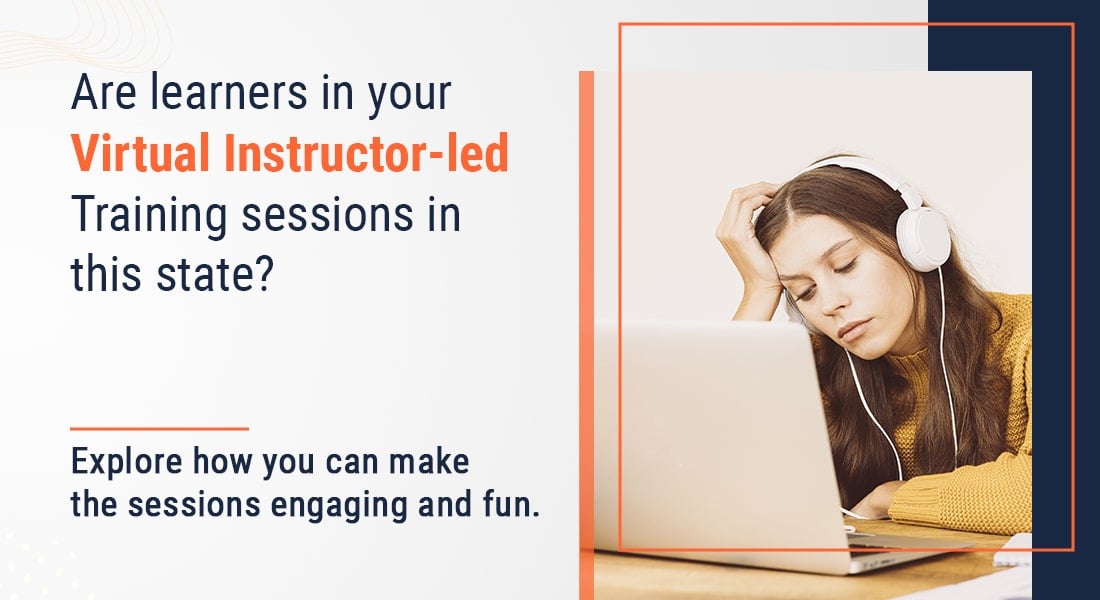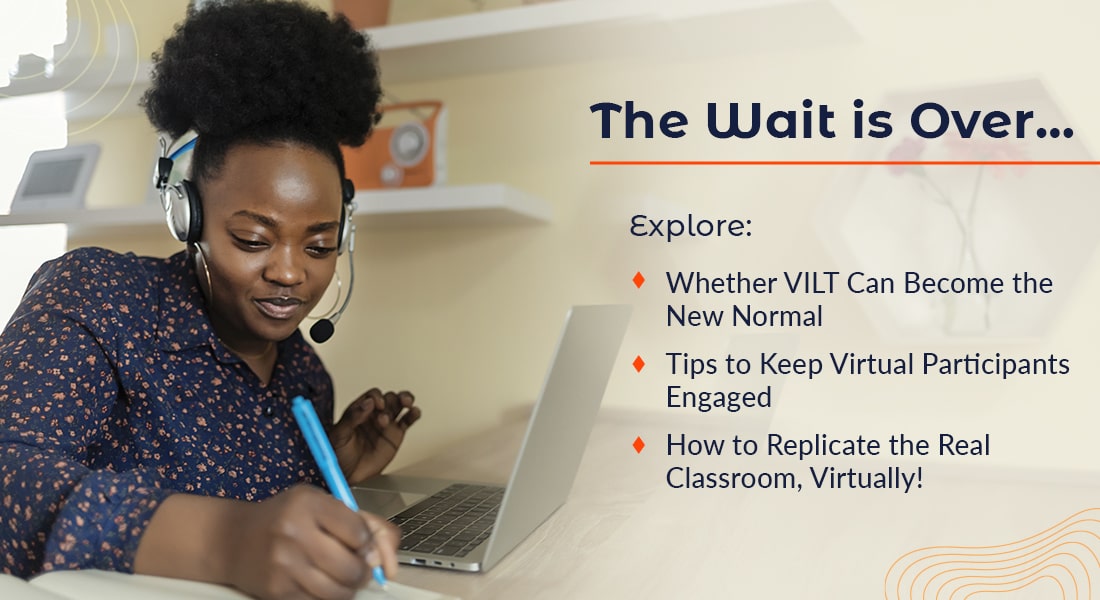Overcoming the Potential Drawbacks of VILT Was Never This Easy!

We had been moving into a digital world (albeit slowly), much before the advent of the global COVID-19 pandemic. Some things like online shopping, social media, entertainment, and games have increasingly shifted to the online medium. Some others like working and learning, on the other hand, had mostly remained offline. However, what made the online shift more urgent and pressing for working and learning, was the need for social distancing that came with COVID-19. There was an immediate felt need for virtual classroom training (VILT), leading to a paradigm shift in how we view and approach training online.
Get started with VILT with this ready reckoner.
What is VILT?
Virtual Instructor-ed Training (VILT) is a mode of online training where the instructor and learners interact through a virtual video-conferencing platform, irrespective of their geographical location and time zones. It is basically the virtual version of offline instructor-led classroom training.
VILT is a video-based, synchronous mode of training – conducted on a virtual medium.
How can we conduct VILT sessions? Through platforms such as Google Meet, Microsoft Teams, Cisco Webex, Slack, and Zoom.
Where Does VILT Fit in Online Training for Corporates?
Virtual instructor-led training:
- Enables direct interaction between the instructor and the learner
- Allows learners and instructors to attend sessions irrespective of geographical location
- Makes interactive sessions possible, whether group or one-on-one
- Helps in the instruction of complex concepts as the instructor is available online
VILT – Some Challenges and Solutions
- Lack of rapport and trust – Use icebreaker sessions
- Reduced attention spans – Present information in diverse formats such to break monotony
- Lack of visual cues – Use polls, chat, and collaborative exercises
In short, VILT offers all the advantages of traditional classroom training, online, thereby saying goodbye to all the logistical hassles of classroom training, while also saving the organization a lot on costs.
Know more about the different kinds of online training in this blog.
Advantages of VILT for Corporate Training
When we shift to traditional online training formats such as eLearning, there is always the apprehension in the back of our minds that learners might miss the personal touch that offline classroom provides. However, a virtual conferencing medium doesn’t take away from the personal touch at all.
Here are some ways in which VILT helps corporate training while keeping it as real as the physical classroom:
Encourages interaction between instructor and participants
Much like the physical classroom, VILT also provides scope for interaction. Whether a learner wants to ask questions, express opinions, or participate in discussions, VILT facilitates it all, promoting collaborative learning.
Offers more opportunities for personalization
VILT sessions provide ample scope for personalization – the sessions are designed with a focus on the learning objectives, and the instructor is free to modify the content and the pace of the session based on learners’ feedback and participation.
Eliminates the need for the instructor & learners to be at the same location
Unlike traditional classroom training, VILT provides complete freedom in terms of location. Neither the instructors nor the learners need to be physically present at a single location for the training session, making VILT a more flexible mode of training than traditional classroom training.
Bottlenecks of VILT in Corporate Training and How to Overcome Them
While VILT is quite an effective mode of training, it’s not without its own set of challenges. What are the most common bottlenecks that we might encounter during VILT sessions for corporate training, and how do we overcome them?
Check this cool infographic on overcoming the limitations of VILT.
Some major bottlenecks that we might encounter are:
Lack of Rapport and Trust
A lack of face-to-face interaction between the instructor and the learner makes it difficult for them to bond. Engagement is needed for learning to be effective. The unfamiliarity of learners with each other might also hinder interaction in the virtual classroom.
Solution:
- Conducting pre-session surveys to identify learners’ pain points and expectations from the session
- Setting up a virtual lobby to encourage learners and instructors to interact before the session, making the experience less daunting for both sides
- Using icebreaker sessions to help break the tension and inject some fun
- Finding creative ways to recognize and appreciate the participation and contribution of each learner
Lack of Visual Cues
Facial expressions, body language, and eye contact in a physical classroom help the instructor keep a finger on the learners’ pulse – their level of interest, understanding, and engagement. Absence of these cues in a virtual classroom can be a huge disadvantage but there are effective ways to overcome it.
Solution:
- Addressing participants by name to add a personal touch
- Using the video facility for introductions, as and when needed
- Incorporating small activities, polls, and mini games to break the monotony
- Encouraging learners to share how they feel, seeking their opinions through chat (using emoticons) or polls, encouraging the use of ‘raise hand’ option to ask questions
The Challenge of Reducing Attention Spans
There may be many reasons for reducing attention spans of learners attending a virtual session. Distractions because of the learning environment and proximity to mobile devices, and the difficulty in focusing and concentrating when the learner is alone in front of a screen can be challenging.
Solution:
- Breaking the session into smaller modules with frequent intervals
- Assessing learner engagement and understanding by asking questions frequently
- Presenting information in diverse formats such as audios, mind maps, infographics, and videos to break the monotony and foster interest
- Using the polling feature to help learners stay in sync with the content being taught
- Using breakout rooms and conducting activities such as games, discussions, and team quizzes to foster teamwork
Inability to Determine Learner Participation
The engagement and retention of the learning depends on the participation of the learner. However, in a virtual classroom, it is difficult for the instructor to know the extent of learner participation or assess understanding and involvement.
Solution:
- Setting ground rules for learners to participate
- Giving learners time and encouraging them to share their views
- Emphasizing the importance of participation and rewarding active participants to instill a healthy spirit of competition
- Minimizing distractions by including activities such as annotations and worksheets
- Using chats to answer questions and take part in discussions
- Creating group learning activities, such as finding solutions to different problems
- Using puzzles, polls, quizzes, discussions; sharing anecdotes to enhance participation
Wrapping Up
It is impossible to envision virtual classrooms completely taking over corporate training, at least for now. However, though classroom learning is never going to go away completely, VILT has its own advantages, as it imitates and even surpasses traditional classroom training in some ways, with emerging technology. VILT packs a punch – combining the convenience of remote learning with the personal touch of classroom ILT.
Want to know more about VILT? Get started on your VILT journey with this free eBook.


![4 Types of Microlearning Assessments and their Benefits [Infographic] 4 Types of Microlearning Assessments and their Benefits [Infographic]](https://blog.commlabindia.com/hs-fs/hubfs/Imported_Blog_Media/microlearning-assessments-formats-benefits-infographic.png?width=900&height=3312&name=microlearning-assessments-formats-benefits-infographic.png)



